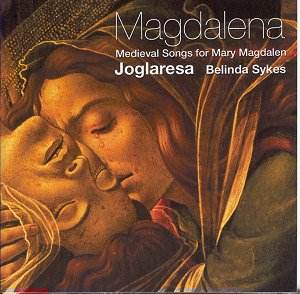"O Mary Magdalen, you, whose sins divine grace
washed in full, intercede with Jesus Christ on our behalf, so
that, with pardon given, He may lead us out of this wretchedness
into eternal joy."
This text (O, Maria Magdalena - track 13) sums
up the role of Mary Magdalen in the Christian Church of the Middle
Ages.
Mary Magdalen was one of the women who followed
Christ and served him with their possessions (Ave, clari generis
- track 3). She also witnessed Jesus' crucifixion and his resurrection.
In particular the crucial role of Mary Magdalen on Easter morning,
looking for the body of Jesus (O Maria, noli flere - track 24),
meeting him as the resurrected and ordered by him to report his
resurrection to his disciples (Victime paschali laudes - track
5), gave her a central role in the Christian Church.
As so often with biblical characters worshipped
as saints, a whole web of myths was woven around her. Very little
of her is known from the gospels. The facts which are told were
used to create a picture of a sinful woman, saved by Christ, and
therefore ideally suited to model the Church and the (sinful)
believers.
According to the Bible seven devils were driven
from her. These devils were associated with specific sins (O Maria,
prius via - track 19). And Pope Gregory the Great, in the late
6th century, associated her with the 'sinful woman' from Luke
7, who washed Jesus' feet (O Magdalena che portasti - track 2),
and also with Mary, the sister of Martha and Lazarus (Peccatrice
nominata - track 22). One of the sins associated with her - probably
referring to the woman Luke reports about - is prostitution (Magdalenam
laude plenam - track 15). As a repentant sinner, seeking forgiveness
from Jesus and being forgiven by him (Chanter voel par grant amour
- track 4), she was the ideal role model for the Church: "Let
us praise the Lord, O Magdalen, bride of Jesus Christ and our
patron, you, the model of repentance and mirror of the church"
(Benedicamus Domino - track 14). Being originally 'peccatrix'
(sinner), 'meretrix' (prostitute), she became 'dilectrix Christi'
(lover of Christ) or even – in a typical medieval metaphor - 'sposa
Jhesu Christi' (bride of Jesus Christ). And she was asked for
intervention on behalf of the sinners, and even was hailed as
"blessed woman" who was able to "dissolve all our sins" (Ave,
beata femina - track 16).
The importance of Mary Magdalen in the Christian
Church of the Middle Ages is reflected in the repertoire recorded
here. Most pieces are anonymous and date from the 14th century
or earlier. Some have the form of motets, others are reflecting
the style of the trouvère repertoire. There are also more
'popular' pieces, the so-called 'laude'. These were sung at meetings
of the 'laudesi', fraternities founded in the 13th century. Most
of these 'laude' are strophic and have refrains. The vocal works
are interspersed by some instrumental pieces.
The line of approach by Belinda Sykes is very
original. It is interesting to see how the official views of the
Church and popular beliefs influenced each other. And more than
any scientific treatise the music and the texts presented here
demonstrate the importance and the mystic character of the worship
of saints in the Christian Church of the Middle Ages.
The performance is excellent. The voices are
all very clear and blend well. Only a couple of instruments are
used when that is appropriate, but in a very moderate and tasteful
way. The character of the pieces – ranging from intimacy to exaltation
- is well delivered. A little questionable is the nasal sound
of the first piece - I don't see why a 'popular' piece should
be sung that way.
In the booklet Susan Haskins has written an excellent
essay about the origin and development of the worshipping of Mary
Magdalen, but I missed some information about the music.
I would recommend this recording very highly,
since the repertoire and the performance are enthralling.
Johan van Veen
Track listing
anon
Magdalena degna da laudare (lauda) [3:50]
St Lorenzo GIUSTINIANI (1381-1456)
O Magdalena che portasti [4:27]
Christian of LILIENFELD (14th c)
Ave, clari generis dulcis Magdalena [5:02]
anon
Chanter voel par grant amour [4:03]
WIPO of Burgundy (11th c)
Victime paschali laude [1:48]
anon
Ortorum virentium/Virga Yesse/Victime paschali laudes [1:07]
Benedicamus Domino/Victime paschali laudes [2:17]
Novum festum celebremus [2:32]
Parlamento (istampita) [3:06]
Co la madre del beato [4:02]
Hodie mater gaudeat ecclesia [2:36]
Salve, pia Magdalena [1:15]
O Maria Magdalena [1:15]
Benedicamus Domino Magdalena [0:58]
Magdalenam laude plenam [0:50]
Ave, beata femina [1:43]
Psallat immensas chorus [3:07]
Ave, plena Magdalena [3:39]
O Maria, prius via [3:46]
Peccatrice nominata (instr) [3:05]
Conon DE BETHUNE (d 1219)
Chançon legiere (estampie) [2:16]
Peccatrice nominata (lauda) [3:04]
O Madalena ch’andasti al sepolcro (lauda) [5:40]
Philippe DE GREVE (13th c)
O Maria, noli flere [3:28]

![]() for details
for details